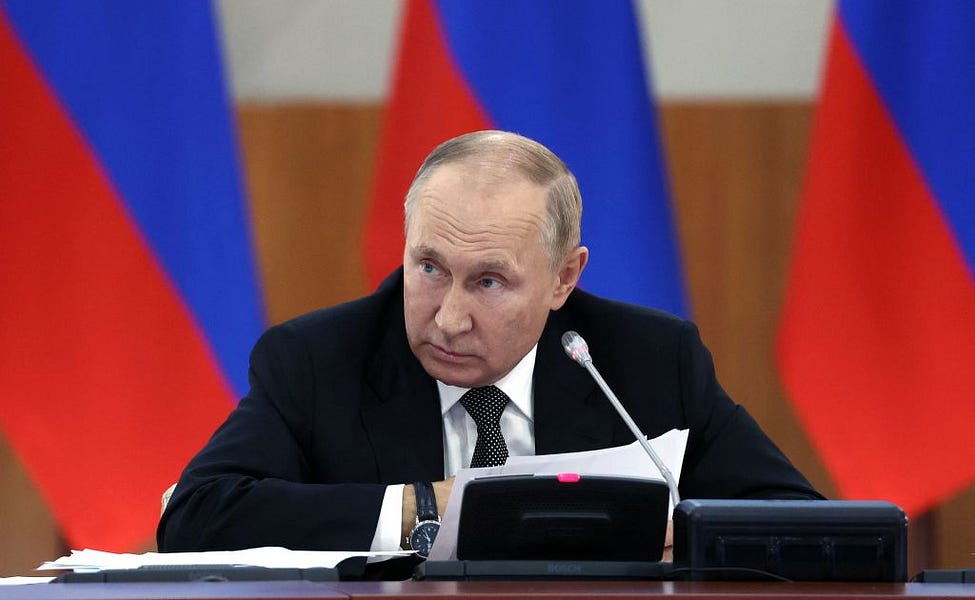Russia has a virtually unlimited supply of some of the most important supplies for its war against Ukraine: fuel and ammunition (though recent reports that Russia needs help from North Korean to get ammunition means it might be running short on some important kinds). Yet the invading force lacks an abundant supply of men. Vladimir Putin is looking to change that.
In late August Putin issued a decree to raise the official number of Russian military personnel to 1.15 million by January 2023, an increase of 137,000 from its current level. This is is not a full mobilization, but it shows Putin is not giving up on the war. Or, at the very least, he wants to send a signal that he is not giving up.
Drawing from a seemingly unlimited supply of military recruits from Russia’s vast peasantry helped make the country a great power in earlier centuries. Those days are over. The Russian army already was facing the effects of a national fertility rate that had collapsed to 1.5 births per woman by 2020. Besides that, Putin has pledged that only volunteers will be used in front-line units. So far he has refused to publicly call for an expanded draft or force a large number of reservists to serve in Ukraine.
The lion’s share of Russia’s combat forces deployed to Ukraine expecting a swift victory in February. Some analysts predicted well-trained and handsomely equipped Russian troops would destroy the Ukrainian state and occupy major cities early on, with under-resourced but highly motivated Ukrainian partisans grinding down the occupation forces. But the Ukrainian state survived, the Ukrainian military remains intact and is still killing Russian soldiers at a good clip.
No one knows the true number of Russian casualties. Russian sources claimed they lost only one sailor in the Moskva sinking. Russia hasn’t released a figure of overall deaths since March, then claiming to have had 498 troops killed and 1,400 wounded. The Ukrainian government has recently claimed that Russia had lost 45,200 personnel in the Ukraine war in the last six months. The Ukrainians have an incentive to exaggerate, but the U.K. chief of the defense staff Admiral Sir Tony Radakin said in July that Russia had suffered about 50,000 casualties (dead and wounded). In early April the Pentagon estimated that Russia has sustained 70,000 to 80,000 casualties. To put these numbers in perspective, the Soviets lost 14,500 soldiers and nearly 54,000 were wounded in their decade-long invasion and occupation of Afghanistan.
Russia continues trying to replace obviously heavy losses in Ukraine without resorting to real mobilization. Advertisements entice young Russians to volunteer for service. The Wagner Group, a Kremlin-linked private military contractor, is producing videos encouraging Russian men to seek glory in the “liberation” of Ukraine. Russia is trying to fill its infantry ranks with strategic missile troops and sailors, but is not getting many takers, according to Ukrainian intelligence.
Russia also has adopted something like the “volunteer battalion” model that Kremlin officials decry in Ukraine. These units are mustered within Russian regions and then dispatched to the war, with some of their costs covered by regional governments. “The recruitment of the local population allows the fighters to be more united and to quickly start to fulfill their tasks,” a recent article in a Russian publication claims. While some of these units may draw on local camaraderie, they are probably also using corrupt local power networks to squeeze families or communities for more men, recruit local gangs, or even punish enemies by having them “volunteered” for the front.
Raising troop levels through a “shadow mobilization” could also be the beginning of a scenario that has been speculated about for months. Putin could declare a unilateral ceasefire, possibly with help from certain Europeans eager for Russian natural gas to flow again. Then, after raising up some new units and training them over the winter, the Russians would restart offensive operations in the spring. Could Ukraine keep taking the punishment, perhaps for years, in an on-again, off-again war? Or, given that 137,000 is roughly the number of conscripts that Russia raises twice a year for conscription, could Putin’s recent announcement be some kind of trial balloon for an annual or semi-annual Ukraine-bound Russian draft?
That would mark a shift in strategy, but manpower might be the key factor in the long war. Ukraine may face similar problems, though it retains a greater reservoir of motivation that can drive volunteers and reduce desertion.
The current offensive in Kherson is a crucial test of the Ukrainian military’s capabilities. If Ukraine does not have the weapons and capacity to win battles, to encircle Russian troops and advance against concentrated Russian firepower, and instead has only enough not to lose, then a manpower-intensive Russian strategy might be the wisest choice for Russian planners. If there is going to be a long war of attrition, Putin may still win.





Please note that we at The Dispatch hold ourselves, our work, and our commenters to a higher standard than other places on the internet. We welcome comments that foster genuine debate or discussion—including comments critical of us or our work—but responses that include ad hominem attacks on fellow Dispatch members or are intended to stoke fear and anger may be moderated.
With your membership, you only have the ability to comment on The Morning Dispatch articles. Consider upgrading to join the conversation everywhere.